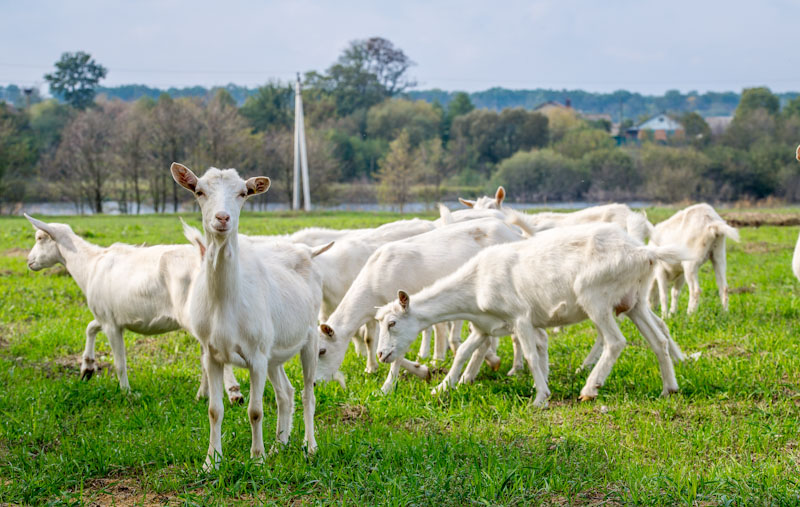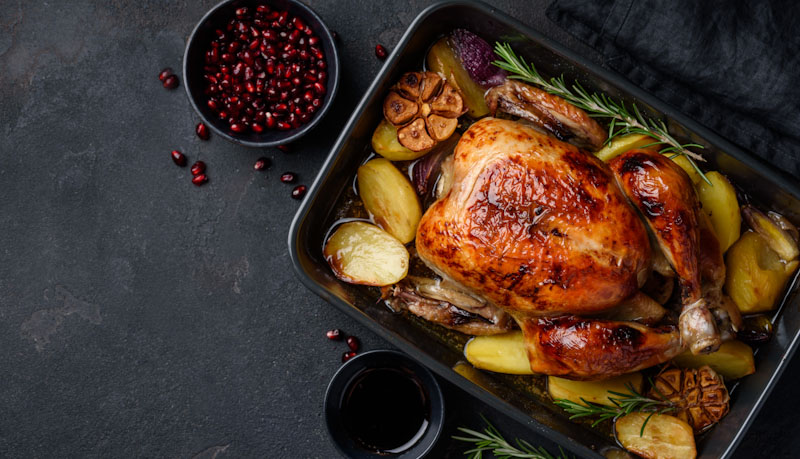Those looking to become self-sufficient by raising livestock are surprised to find out that the global frontrunner in the realm of protein sources is goat meat. In fact, approximately 70% of the world’s population leans on goat meat as their primary source of sustenance.
While goat meat, often referred to as chevon, hasn’t historically enjoyed the same level of popularity in the United States as beef, chicken, or pork, it is steadily gaining ground and finding its way onto more American tables.
Goat consumption in the United States has surged, rising by 320% since 1999 and by more than 130% since 2002. The U.S. has had no goat export market since 1990, primarily due to the current supply falling short of the demand for goat meat, which is at just under 50%. Each year, approximately 1.5 million goats contribute to the annual consumption of goat meat in the U.S.
Earn Your Food Independence NOW!
Health Benefits of Goat Meat
The appeal of goat meat goes beyond its delicious taste, as it offers a range of health benefits that have been instrumental in driving its growing popularity in the United States in recent years. Compared to beef, pork, and even chicken, goat meat stands out as a particularly healthy choice.
First and foremost, goat meat is a nutritional power booster. It has a significantly lower calorie count, less fat, and lower cholesterol levels when compared to other meat products. These qualities make it an ideal option for health-conscious individuals seeking a balanced diet.
Furthermore, goat meat is an excellent source of essential nutrients. The meat contains high-quality protein, vitamins, and minerals, including iron and zinc. These nutrients are crucial for maintaining overall health and well-being.
Additionally, goat meat is known for its relatively low saturated fat content, which is linked to heart health. This makes it a favorable choice for those looking to reduce their risk of heart-related conditions. The presence of conjugated linoleic acid (CLA), a beneficial fatty acid found in goat meat, further contributes to its potential health advantages.
The nutritional profile of goat meat, with its lower calorie, fat, and cholesterol content, coupled with its abundance of essential nutrients and heart-friendly properties, has fueled its increased consumption in the United States. With its remarkable combination of flavor and health benefits, goat meat has found its place on the plates of many health-conscious individuals.
Nutrition comparison between chevon and other meats
It’s important to note that specific values can vary based on factors such as cuts of meat and preparation methods. Here are approximate values for comparison:
Calories and Fat Content
Chevon (Goat Meat) – Calories (per 3-ounce cooked portion): Approximately 122 calories. Total Fat: About 2.6 grams
Beef (Lean Cut, e.g., Sirloin) – Calories: Approximately 158 calories. Total Fat: Around 6 grams
Pork (Lean Cut, e.g., Pork Tenderloin) – Calories: Approximately 143 calories. Total Fat: About 3.5 grams
Chicken (Skinless, Boneless Chicken Breast) – Calories: Approximately 128 calories. Total Fat: About 2.7 grams.
Protein and Amino Acids
Chevon (Goat Meat) – Protein (per 3-ounce cooked portion): Approximately 23 grams
Beef (Lean Cut, e.g., Sirloin) – Protein: Approximately 26 grams
Pork (Lean Cut, e.g., Pork Tenderloin) – Protein: Approximately 24 grams
Chicken (Skinless, Boneless Chicken Breast) – Protein: Approximately 24 grams
Cholesterol Levels
Chevon (Goat Meat) – Cholesterol (per 3-ounce cooked portion): Approximately 75 milligrams
Beef (Lean Cut, e.g., Sirloin) – Cholesterol: Approximately 60 milligrams
Pork (Lean Cut, e.g., Pork Tenderloin) – Cholesterol: Approximately 63 milligrams
Chicken (Skinless, Boneless Chicken Breast) – Cholesterol: Approximately 73 milligrams
Goat requirements to maintain a healthy herd
Goats have natural browsing tendencies, which involve their preference for brushy plants and shrubs over grass. They are well-suited for smaller-scale farms in comparison to beef cattle. Approximately eight goats can be comfortably supported per acre of land that offers adequate browse.
Their remarkable foraging abilities make goats particularly content in areas teeming with brush. This trait becomes invaluable when it comes to clearing overgrown land. In fact, a lot of small farmers simply fence off an area that needs to be cleared and introduce an appropriate number of goats. The goats will do most of the cleaning, requiring minimal labor on their side.
In addition to the available browse and pasture, ensuring the optimal health and meat production of goats necessitates supplemental feeding, typically in the form of mixed grains or goat-specific pelleted feed. During the winter months, when forage becomes scarce, providing hay and other nutritional supplements becomes essential. Moreover, it’s crucial to grant goats access to a well-balanced blend of minerals. These minerals can be provided in loose or block form.
One word of caution regarding the pasture space required for goats. Due to their natural inquisitive nature, goats are experts at escaping and exploring. They may require less pasture space than cattle, but even so, they will go far beyond their designated living area. Goats can climb, jump, and squeeze into surprisingly tight spaces. So, to keep them “in place,” a top-quality fence is indispensable. You might want to install a five-strand barbed wire, woven wire, or even an electric fence.
When you cover the fence issue, you will also have to plan for sheltering your goats. You will need to provide a shelter that keeps the goats dry (they don’t like getting wet) and protects them from drafts. Also, regarding sheltering, some goats are territorial and may prevent others from getting in. Many farmers prefer to build multiple smaller shelters scattered across the fenced area. In general, you will require 20 square feet per goat to ensure their comfort.
Keeping the herd healthy
Health concerns in meat goats often manifest through a combination of internal and external parasites, which can significantly impact the well-being and productivity of these animals. Goats burdened with a high parasite load tend to experience weight loss, give birth to kids with lower birth weights, and become more susceptible to various diseases.
These parasites can be broadly categorized into external and internal varieties, with mites, ticks, and lice constituting the external threats, while intestinal worms represent the internal hazard.
Given that many parasites are transmitted from one animal to another through ground contact, one effective strategy to mitigate infestations is to implement a pasture rotation system. By regularly rotating pastures, you can minimize the likelihood of parasite build-up and provide a healthier environment for your herd. To further safeguard your goats’ well-being, it’s advisable to consult with a veterinarian and establish a consistent schedule for vaccinations and worm control medications.
Maintaining good health in goats is a multifaceted endeavor. One crucial aspect is ensuring that goats have unrestricted access to a high-quality goat mineral mix. This supplement provides essential nutrients vital for their overall health. Furthermore, regular hoof trimming is essential to keep the goats’ feet in optimal condition, preventing discomfort and lameness.
For male goats kept for meat production, it’s recommended to consider castration at the age of two months. This practice not only helps prevent the development of a strong flavor in the meat but also makes for more manageable and docile animals. These castrated male goats, known as wethers, are typically raised until they reach a weight of 100 to 125 pounds before they are ready for slaughter. This approach ensures that the meat quality meets the desired standards.
Keeping your herd safe from predators
Goats, like many other livestock, face potential threats from a range of predators, which can include coyotes, bobcats, and, in certain regions of the country, even larger predators like mountain lions and wolves. To ensure the safety of your herd, it’s essential to implement strong protective measures.
One such method, which I’ve mentioned earlier, is establishing high-quality fencing around your goat enclosure. This serves as an effective deterrent against ground-based predators. In areas where predators are known to be active, it’s prudent to consider housing your goats inside barns or shelters during the night, providing an extra layer of protection.
Many goat owners opt to employ guard animals to strengthen their goatherds’ security. Among the most common choices are dog breeds such as the Great Pyrenees and Anatolian Shepherds, which have a rich history of guarding herd animals and are known for their protective instincts and loyalty.
Besides guard dogs, some goat livestock owners also choose to integrate donkeys or mules into their herds. These animals possess a natural aversion to predators and can either chase them away or raise the alarm through vocalization when predators are in the vicinity. Their presence provides an additional layer of security for your goats, helping to deter potential threats.
With these protective strategies and selecting the right guard animals, you can minimize the risk of predator attacks and create a safer environment for your goat herd.
Goat breeds recommended for meat production
Although goats of any breed can be consumed, certain breeds have been selectively bred to excel in traits that make them particularly well-suited for meat production. These meat-focused breeds are known for their ability to efficiently gain weight, possess a well-muscled physique, and offer a mild and palatable meat flavor. Here’s a selection of some of the most popular meat breeds:
Boer Goats: Boer goats are celebrated for their exceptional meat qualities. They are renowned for their rapid weight gain, solid musculature, and flavorful meat. Their high growth rate and adaptability make them a top choice for meat production.
Kiko Goats: Kikos are hardy goats with a strong constitution, making them well-suited for meat production. They possess impressive growth rates, high fertility and provide lean and delectable meat.
Spanish Goats: Spanish goats, also known as “brush goats,” have gained popularity for their adaptability and ability to thrive in diverse environments. While they may not be as large as Boer goats, their meat is recognized for its distinctive flavor and quality.
Myotonic Goats (Fainting Goats): These goats have unique characteristics, including a condition called myotonia that causes their muscles to stiffen when startled. Despite this quirk, they are valued for their meat, which is tender and flavorful.
Savanna Goats: Savanna goats are robust and adaptable, making them an excellent choice for meat production. They are prized for their large frame, impressive meat yield, and resistance to various environmental conditions.
Nubian Goats: Nubians, known for their distinctive floppy ears, are not primarily meat goats, but they produce flavorful and tender meat, especially in crossbreeding programs. Their milk is also highly regarded in the dairy industry.
Butchering requirements
Once your goats have reached maturity and it’s time for meat production, the butchering process becomes a crucial step in the journey from farm to table. While commercial butcher shops can handle this task, home butchering offers cost savings and provides greater control over the final product. To effectively and efficiently process goat meat at home, there are specific tools and methods you should consider.
Required Tools and Equipment:
Knives: Sharp skinning knives are indispensable for removing the hide and breaking down the primal cuts of goat meat. Opt for knives with blades in the four-to-six-inch range, featuring a sharp point and a slightly flexible blade. In addition to skinning knives, having a larger knife with a heavy, stiff blade is beneficial for slicing through large roasts or separating bones.
Meat Saw: A replaceable blade meat saw simplifies sectioning ribs, cutting chops, or removing shanks from the lower leg of the animal. Look for a model with a thick handle that provides a secure grip, especially when your hands are wet. Also, a user-friendly blade replacement system can enhance efficiency.
Grinder: A meat grinder proves invaluable for utilizing the smaller meat scraps left over from larger cuts. Ground meat can be used in various culinary applications, such as burgers, sauces, and meatballs. Hand-crank grinders are cost-effective but require more manual effort, whereas electric grinders offer faster and less labor-intensive operation. Seek models with replaceable grinding plates for convenience and straightforward disassembly to facilitate cleanup.
Vacuum Sealers: While freezer paper or freezer-weight zip-style bags can serve for long-term storage, vacuum sealers are ideal for preserving the freshness of your goat meat over an extended period. Vacuum sealers operate by removing as much air as possible from the bag before heat-sealing along the outer edge, substantially reducing the risk of freezer burn.
Hoist: Using a hoist to lift the goat off the ground simplifies the physical demands of butchering large animals. You can opt for hand-crank models or those powered by an electric winch, depending on your preferences and needs.
Additional Requirements:
In addition to the tools mentioned, ensure you have access to a clean and well-ventilated butchering area with ample workspace. A sturdy butchering table or surface, along with adequate lighting, is essential for precision and safety. It’s also vital to have a good supply of clean, fresh water for cleaning equipment and rinsing meat.
Remember to prioritize safety and hygiene during the butchering process, and consider wearing appropriate personal protective equipment, such as gloves and aprons, to maintain cleanliness and reduce the risk of contamination.
Lastly, it’s recommended to seek guidance or training in proper butchering techniques if you’re new to this process to ensure a successful and safe meat production experience.
Concluding
Meat goat farming offers a path to profit on a small farm and a year-round supply of wholesome meat for your family. To dive into this endeavor with success, consider the following steps:
Farm Visits: Gain insights from local farmers by visiting their active farms. Learn about goat breeds, fencing styles, and predator management.
4-H Clubs: Connect with local 4-H clubs for additional guidance and educational resources on goat farming.
Additional Considerations:
- Ensure your farm has the right infrastructure for goat care.
- Select suitable goat breeds for your goals.
- Learn about goat health, nutrition, and management.
- Develop effective predator protection measures.
- Understand any legal and regulatory requirements for goat farming.
By leveraging these resources and insights, you can embark on a rewarding journey in meat goat farming, whether for profit or to secure a year-round meat supply for your family.










Levi | January 10, 2024
|
I raise boers and nubians for both meat and milk. I definitely recommend the welded panels with the 4″ square spacing for fence. It’s the only fencing I have that holds up to the larger bodied goats. The 4″ openings prevent all but the youngest goats from getting their head stuck in the opening.
Sandy Stetz | January 22, 2024
|
It would be nice if this article could be printed.
JOHN SILVERS | January 25, 2024
|
Sandy…at the end of the article is a blue sentence “Download as a PDF”
Download the article to your desktop, then print it.
You’ll have an electronic copy and a hard copy.
Christina Lilienthal | January 23, 2024
|
The author did a great job on this comprehensive article. I raise Boer goats (Seadawn Farms) in Oregon and will definitely share this article with others. I appreciate the well-done piece of work!!
JOHN SILVERS | January 25, 2024
|
I have no brush or foraging area on my suburban property. It is enclosed with a 6′ wood fence.
Can I feed goats processed goat food only?
Do they poop a lot?
Are they loud?